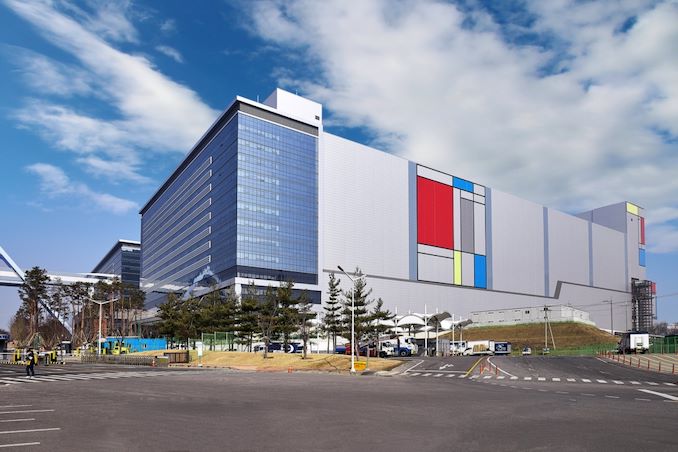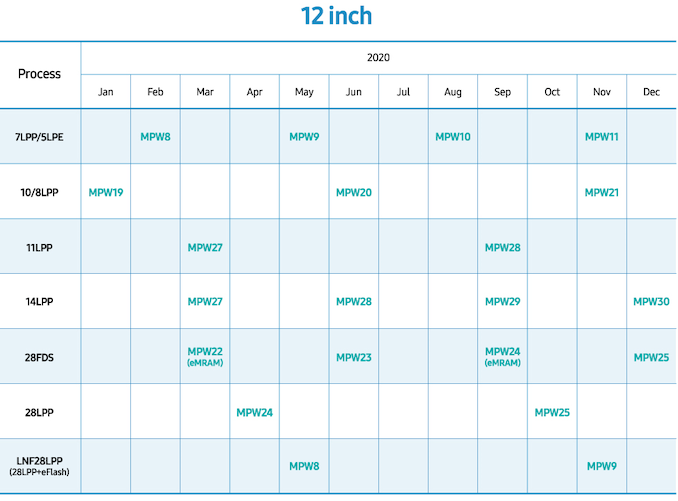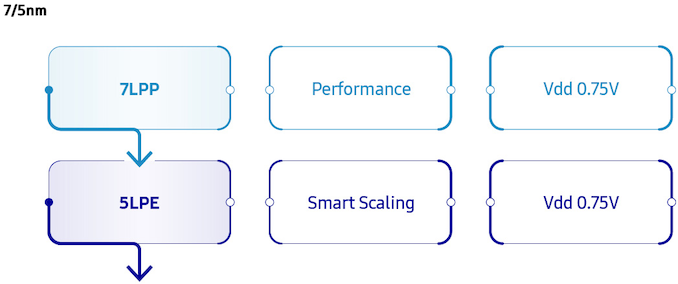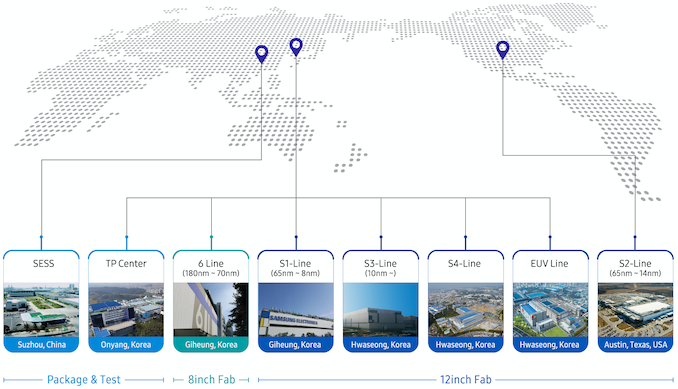Samsung Starts Mass Production at V1: A Dedicated EUV Fab for 7nm, 6nm, 5nm, 4nm, 3nm Nodes
by Anton Shilov on February 20, 2020 1:00 PM EST
Samsung Foundry has started mass production of chips using its 6LPP and 7LPP manufacturing processes at its new V1 fab. The new facility employs one of the industry’s first production lines built from the ground up for technologies that heavily use EUV tools.
EUVL is a key enabler for Samsung’s next-generation leading-edge fabrication processes as it allows to reduce usage of multipatterning, and increases yields of chips architected for smaller technologies. Samsung currently uses EUVL equipment for its 6LPP and 7LPP nodes, and will expand its usage in future nodes such as 5LPE, 4LPE, 3GAE, and 3GAP processes.
| Advertised PPA Improvements of New Process Technologies Data announced by companies during conference calls, press briefings and in press releases |
||||||
| 7LPP vs 10LPE |
6LPP vs 7LPP |
5LPE vs 7LPP |
3GAE vs 7LPP |
|||
| Power | 50% | lower | 20% | 50% | ||
| Performance | 20% | ? | 10% | 35% | ||
| Area Reduction | 40% | ~9% | <20% | 40% | ||
Samsung Foundry’s 7LPP and 6LPP process technologies are used to make advanced mobile SoCs that will be shipped in Q1. The contract manufacturer of semiconductors does not disclose names of its client(s), but it is noteworthy that its 6LPP technology is not a part of its MPW (multi project wafer) shuttle program, which may indicate that the process is only available for Samsung itself and/or select customers who do not use MPWs.
Samsung’s 6LPP is a evolution of its 7LPP node that offers slightly higher (~10%) transistor density and lower power, but is compatible with, and can reuse IP initially developed for 7LPP. Furthermore, 6LPP supports smart structures for designers eager to invest in all-new IP, as well as multi diffusion break feature. Meanwhile, 5LPE promises to bring further advantages when it comes to power, performance, when compared to 6LPP.
6LPP looks to be a limited offer node for select customers, whilst Samsung's focus in the future looks to be on its new 5LPE node.
| Global Manufacturing Sites of Samsung Foundry | ||||||||
| Name | 6-Line | S1 | S2 | S3 | S4 | V1 | ||
| Nodes | 180~65nm | 65~8nm | 65~11nm | 10nm~ | 65nm~ | 7nm~ | ||
| Location | Giheung, South Korea | Austin, Texas | Hwaseong, South Korea | |||||
| Wafer Size | 200 mm | 300 mm | ||||||
Samsung’s V1 fab is located in Hwaseong, Korea, adjacent to its S3 line, where Samsung started initial ramp of chips made using its 7LPP technology. The company began construction of V1 in February 2018, and initiated test wafer production in the second half of 2019. Samsung continues to ramp up its V1 fab now and says that by the end of the year its total capacity for EUV-enabled 7LPP and below nodes will be three times higher than it was in 2019. Meanwhile, cumulative investments in the V1 line will hit $6 billion by the end of 2020.
Related Reading:
- ASML Ramps Up EUV Scanners Production: 35 in 2020, Up to 50 in 2021
- EUV Demand is Up: EUV Device Manufacturer ASML Beats Sales Estimates
- Samsung Starts Mass Production of Chips Using Its 7nm EUV Process Tech
- Samsung Foundry Updates: 8LPU Added, EUVL on Track for HVM in 2019
- Samsung Completes Development of 5nm EUV Process Technology
Source: Samsung














29 Comments
View All Comments
FullmetalTitan - Thursday, February 20, 2020 - link
Lack of edit strikes again.Should be 300mm* instead of 200mm
boozed - Thursday, February 20, 2020 - link
That's not very logarithmicazfacea - Thursday, February 20, 2020 - link
meanwhile intel is trying to decide whether to grow 14nm capacity by 0.00002 % or to bring back 45nm chipsetsteamet - Thursday, February 20, 2020 - link
Processes has always been defined with two significant figures, why are we all the sudden down to one figure?I mean, if we are talking about eg 20% reduction as significant, the the difference between 7.4 and 6.6 most also be significant!
Krayzieka - Friday, February 21, 2020 - link
Its time to sell Intel their security flaw getting to the point of too easy for hacker. Now intel lag in both advanced technology amd architueture. Tc in mass production mode and using new material. Amd will be golden winner unless intel bribe hardermercucu1111 - Friday, February 21, 2020 - link
They said Area Reduction of 5nm node is 25%. And 3GAE is 45%, 3GAP has progression of BEOL.https://news.samsung.com/kr/카드-뉴스-5나노의-벽을-넘은-삼성전자-...
levizx - Monday, February 24, 2020 - link
"Samsung is collaborating with customers on 6nm, a customized EUV-based process node"There's no need to speculate. 6LPP is for specific customer(s).
mercucu1111 - Wednesday, February 26, 2020 - link
Hua###Anymoore - Wednesday, March 4, 2020 - link
Samsung mentioned they did not change pitch going from 7LPP to 5LPE, so density improvements are from diffusion breaks, gate over contact, etc. Since their current output is a third of what it could be, it must be quite low production volume right now. The overall EUV output rate per tool worldwide in 2019 was estimated less than 500 wpd, less than 1000-1500 Samsung targeted for HVM production.